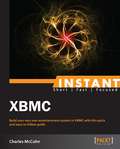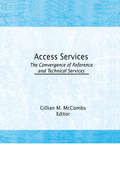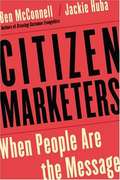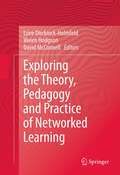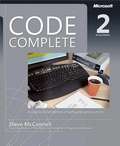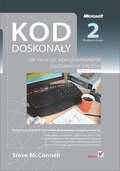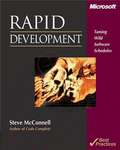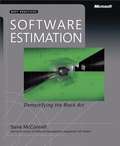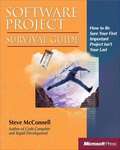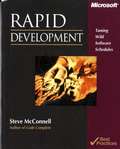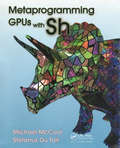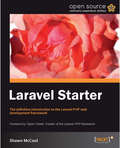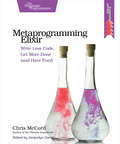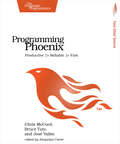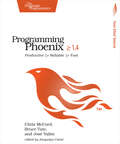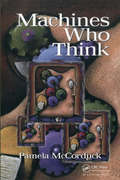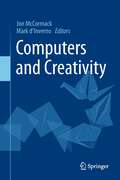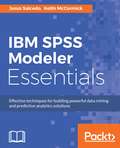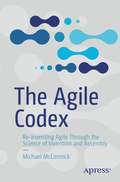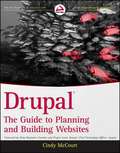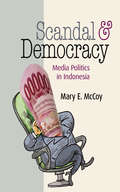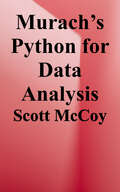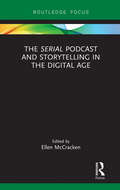- Table View
- List View
Instant XBMC
by Charles MccolmGet to grips with a new technology, understand what it is and what it can do for you, and then get to work with the most important features and tasks. This is a precise written guide to understanding the functioning of XBMC and learning exciting things such as streaming music and videos from the Internet to your home or business.This book is great for those who want to get XBMC up and installed with an out-of-the-box experience on PC hardware. It is great for those who wish to learn more about XBMC as an entertainment system that stores and streams media to their Windows, Linux, or Mac-OS-X-based PC and how to stream from an iOS-based device to XBMC using Airplay.
How to Make a Robot
by Gordon McCombLearn the basics of modern robotics while building your own intelligent robot from scratch! You'll use inexpensive household materials to make the base for your robot, then add motors, power, wheels, and electronics. But wait, it gets better: your creation is actually five robots in one! -- build your bot in stages, and add the features you want. Vary the functions to create a robot that's uniquely yours. Mix and match features to make your own custom robot: Flexible Motorized Base -- a playpen for all kinds of programming experiments; Obstacle Detector -- whiskers detect when your robot has bumped into things; Object Avoider -- ultrasonic sound lets your robot see what's in front of it; Infrared Remote Control -- command your robot from your easy chair; Line Follower -- use optics to navigate your bot; have races with other robot builders! You will learn how switches, ultrasonics, infrared detectors, and optical sensors work. Install an Arduino microcontroller board and program your robot to avoid obstacles, provide feedback with lights and sound, and follow a tracking line. In this book you will combine multiple disciplines -- electronics, programming, and engineering -- to successfully build a multifunctional robot. You'll discover how to: construct a motorized base; set up an Arduino to function as the brainuse "whisker" switches to detect physical contact; avoid obstacles with ultrasonic sensors; teach your robot to judge distances; use a universal remote to control your robot; install and program a servo motor; respond to input with LEDs, buzzers, and tones; mount line-following sensors under your robot. And more. Everything is explained with lots and lots of full-color line drawings. No prior experience is necessary. You'll have fun while you learn a ton!
Access Services: The Convergence of Reference and Technical Services
by Gillian M. McCombsThis book takes a close look at the recent changing emphasis from collections to access, and from document description to document delivery. As the automation of library processes has moved from technical services to reference services, the roles of the professionals working in those capacities have changed dramatically. Library administrators who are looking to redeploy resources will gain helpful insights from the experiences of librarians who have already redirected their organizations. This helpful volume will be of tremendous assistance in redefining the traditional roles of reference and technical librarians. Access Services offers new insights into the movement from bibliographic access to information access that is reshaping reference services today. Informative discussions on topics such as cross-training experiments, revised organizational structures, the new role of the bibliographic utilities, library school education for the redefined professional, and changes in cataloging codes reveal what impact this trend has for librarians, services, and patrons.
Citizen Marketers: When People Are the Message
by Ben Mcconnell Jackie HubaCitizen marketers: Who are they? What motivates them? Marketing experts Ben McConnell and Jackie Huba explore the ramifications of social media in Citizen Marketers. As everyday people increasingly create content on behalf of companies, brands or products, they are collaborating with others just like themselves and forming ever-growing communities of enthusiasts and evangelists. From the rough to the sophisticated, the ""user-generated media"" of blogs, online bulletin boards, podcasts, photos, songs, and animations are influencing companies' customer relationships, product design, and marketing campaigns, whether they participate willingly or not.
Exploring the Theory, Pedagogy and Practice of Networked Learning
by David Mcconnell Lone Dirckinck-Holmfeld Vivien HodgsonThis book will be based on a selection of high quality research papers presented at the Networked Learning Conference, May3-4, 2010. The Networked Learning Conference is an international, research-based conference. Since its inception in 1998 the conference has developed a strong following by international researchers. In addition it is well supported by practitioners, managers and learning technologists interested in contributing to and hearing about research in this area. The conference is considered a major event in the international 'technology enhanced learning' conference circuit. This edited volume presents cutting edge research that will explore current trends and advances in research on networked learning, technology enhanced learning and e-learning.
Code Complete
by Steve McconnellWidely considered one of the best practical guides to programming, Steve McConnell's original CODE COMPLETE has been helping developers write better software for more than a decade. Now this classic book has been fully updated and revised with leading-edge practices--and hundreds of new code samples--illustrating the art and science of software construction. Capturing the body of knowledge available from research, academia, and everyday commercial practice, McConnell synthesizes the most effective techniques and must-know principles into clear, pragmatic guidance. No matter what your experience level, development environment, or project size, this book will inform and stimulate your thinking--and help you build the highest quality code. Discover the timeless techniques and strategies that help you: Design for minimum complexity and maximum creativity Reap the benefits of collaborative development Apply defensive programming techniques to reduce and flush out errors Exploit opportunities to refactor--or evolve--code, and do it safely Use construction practices that are right-weight for your project Debug problems quickly and effectively Resolve critical construction issues early and correctly Build quality into the beginning, middle, and end of your project
Kod Doskonały: Jak tworzyć oprogramowanie pozbawione błędów (in Polish)
by Steve McconnellKsika jest przejrzyst kompilacj najlepszych technik programowania, zdobya wielkie uznanie w rodowisku.
Rapid Development
by Steve McconnellCorporate and commercial software-development teams all want solutions for one important problem--how to get their high-pressure development schedules under control. In RAPID DEVELOPMENT, author Steve McConnell addresses that concern head-on with overall strategies, specific best practices, and valuable tips that help shrink and control development schedules and keep projects moving. Inside, you'll find: A rapid-development strategy that can be applied to any project and the best practices to make that strategy work Candid discussions of great and not-so-great rapid-development practices--estimation, prototyping, forced overtime, motivation, teamwork, rapid-development languages, risk management, and many othersA list of classic mistakes to avoid for rapid-development projects, including creeping requirements, shortchanged quality, and silver-bullet syndromeCase studies that vividly illustrate what can go wrong, what can go right, and how to tell which direction your project is goingRAPID DEVELOPMENT is the real-world guide to more efficient applications development.
Software Estimation: Demystifying the Black Art
by Steve McconnellOften referred to as the "black art" because of its complexity and uncertainty, software estimation is not as difficult or puzzling as people think. In fact, generating accurate estimates is straightforward--once you understand the art of creating them. In his highly anticipated book, acclaimed author Steve McConnell unravels the mystery to successful software estimation--distilling academic information and real-world experience into a practical guide for working software professionals. Instead of arcane treatises and rigid modeling techniques, this guide highlights a proven set of procedures, understandable formulas, and heuristics that individuals and development teams can apply to their projects to help achieve estimation proficiency. Discover how to: Estimate schedule and cost--or estimate the functionality that can be delivered within a given time frame Avoid common software estimation mistakes Learn estimation techniques for you, your team, and your organization * Estimate specific project activities--including development, management, and defect correction Apply estimation approaches to any type of project--small or large, agile or traditional Navigate the shark-infested political waters that surround project estimates When many corporate software projects are failing, McConnell shows you what works for successful software estimation.
Software Project Survival Guide
by Steve Mcconnell<div xmlns="http://www.w3.org/1999/xhtml"><p>This is the field guide for everyone involved in software development--especially those without formal management training. Acclaimed expert Steve McConnell maps out a proven approach to project management</p></div>
Rapid Development: Taming Wild Software Schedules
by Steve M. McconnellGet your development schedules under control and on track! Corporate and commercial software-development teams all want solutions for one important problem--how to get their high-pressure development schedules under control.
Metaprogramming GPUs with Sh
by Michael McCool Stefanus Du ToitThis book is a high-level overview of Sh and its relationship to other realtime shading and Graphics processing unit programming languages. It is a reference manual and language specification and methodically and exhaustively presents details of the various features of Sh.
Laravel Starter
by Shawn MccoolThis book is a practical, task-based, step-by-step tutorial that demonstrates topics ranging from MVC code-separation, to code-modularity, to utilizing ActiveRecord for data abstraction which are explained from the ground-up to provide a strong framework of understanding for creating professional web-applications with Laravel. This book is ideal for programmers familiar with PHP who are interested in learning the Laravel way of solving the common problems faced in their day to day work.
Metaprogramming Elixir: Write Less Code, Get More Done (and Have Fun!)
by Chris McCordWrite code that writes code with Elixir macros. Macros make metaprogramming possible and define the language itself. In this book, you'll learn how to use macros to extend the language with fast, maintainable code and share functionality in ways you never thought possible. You'll discover how to extend Elixir with your own first-class features, optimize performance, and create domain-specific languages. Metaprogramming is one of Elixir's greatest features. Maybe you've played with the basics or written a few macros. Now you want to take it to the next level. This book is a guided series of metaprogramming tutorials that take you step by step to metaprogramming mastery. You'll extend Elixir with powerful features and write faster, more maintainable programs in ways unmatched by other languages.You'll start with the basics of Elixir's metaprogramming system and find out how macros interact with Elixir's abstract format. Then you'll extend Elixir with your own first-class features, write a testing framework, and discover how Elixir treats source code as building blocks, rather than rote lines of instructions. You'll continue your journey by using advanced code generation to create essential libraries in strikingly few lines of code. Finally, you'll create domain-specific languages and learn when and where to apply your skills effectively.When you're done, you will have mastered metaprogramming, gained insights into Elixir's internals, and have the confidence to leverage macros to their full potential in your own projects.
Programming Phoenix: Productive |> Reliable |> Fast
by Chris McCord Bruce Tate Jose ValimDon't accept the compromise between fast and beautiful: you can have it all. Phoenix creator Chris McCord, Elixir creator Jose Valim, and award-winning author Bruce Tate walk you through building an application that's fast and reliable. At every step, you'll learn from the Phoenix creators not just what to do, but why. Packed with insider insights, this definitive guide will be your constant companion in your journey from Phoenix novice to expert, as you build the next generation of web applications.Phoenix is the long-awaited web framework based on Elixir, the highly concurrent language that combines a beautiful syntax with rich metaprogramming. The authors, who developed the earliest production Phoenix applications, will show you how to create code that's easier to write, test, understand, and maintain. The best way to learn Phoenix is to code, and you'll get to attack some interesting problems. Start working with controllers, views, and templates within the first few pages. Build an in-memory repository, and then back it with an Ecto database layer. Learn to use change sets and constraints that keep readers informed and your database integrity intact. Craft your own interactive application based on the channels API for the real-time, high-performance applications that this ecosystem made famous. Write your own authentication components called plugs, and even learn to use the OTP layer for monitored, reliable services. Organize your code with umbrella projects so you can keep your applications modular and easy to maintain.This is a book by developers and for developers, and we know how to help you ramp up quickly. Any book can tell you what to do. When you've finished this one, you'll also know why to do it.What You Need:To work through this book, you will need a computer capable of running Erlang 17 or better, Elixir 1.1, or better, Phoenix 1.0 or better, and Ecto 1.0 or better. A rudimentary knowledge of Elixir is also highly recommended.
Programming Phoenix 1.4: Productive |> Reliable |> Fast
by Chris McCord Bruce Tate Jose ValimDon't accept the compromise between fast and beautiful: you can have it all. Phoenix creator Chris McCord, Elixir creator Jose Valim, and award-winning author Bruce Tate walk you through building an application that's fast and reliable. At every step, you'll learn from the Phoenix creators not just what to do, but why. Packed with insider insights and completely updated for Phoenix 1.4, this definitive guide will be your constant companion in your journey from Phoenix novice to expert, as you build the next generation of web applications. Phoenix is the long-awaited web framework based on Elixir, the highly concurrent language that combines a beautiful syntax with rich metaprogramming. The best way to learn Phoenix is to code, and you'll get to attack some interesting problems. Start working with controllers, views, and templates within the first few pages. Build an in-memory context, and then back it with an Ecto database layer, complete with changesets and constraints that keep readers informed and your database integrity intact. Craft your own interactive application based on the channels API for the real-time applications that this ecosystem made famous. Write your own authentication plugs, and use the OTP layer for supervised services. Organize code with modular umbrella projects. This edition is fully updated for Phoenix 1.4, with a new chapter on using Channel Presence to find out who's connected, even on a distributed application. Use the new generators and the new ExUnit features to organize tests and make Ecto tests concurrent. This is a book by developers and for developers, and we know how to help you ramp up quickly. Any book can tell you what to do. When you've finished this one, you'll also know why to do it. What You Need:To work through this book, you will need a computer capable of running Erlang 18 or higher, Elixir 1.5 or higher, and Phoenix 1.4 or higher. A rudimentary knowledge of Elixir is also highly recommended.
Machines Who Think: A Personal Inquiry into the History and Prospects of Artificial Intelligence
by Pamela McCorduck Cli CfeThis book is a history of artificial intelligence, that audacious effort to duplicate in an artifact what we consider to be our most important property—our intelligence. It is an invitation for anybody with an interest in the future of the human race to participate in the inquiry.
Computers and Creativity
by Jon Mccormack Mark D’invernoThis interdisciplinary volume introduces new theories and ideas on creativity from the perspectives of science and art. Featuring contributions from leading researchers, theorists and artists working in artificial intelligence, generative art, creative computing, music composition, and cybernetics, the book examines the relationship between computation and creativity from both analytic and practical perspectives. Each contributor describes innovative new ways creativity can be understood through, and inspired by, computers. The book tackles critical philosophical questions and discusses the major issues raised by computational creativity, including: whether a computer can exhibit creativity independently of its creator; what kinds of creativity are possible in light of our knowledge from computational simulation, artificial intelligence, evolutionary theory and information theory; and whether we can begin to automate the evaluation of aesthetics and creativity in silico. These important, often controversial questions are contextualised by current thinking in computational creative arts practice. Leading artistic practitioners discuss their approaches to working creatively with computational systems in a diverse array of media, including music, sound art, visual art, and interactivity. The volume also includes a comprehensive review of computational aesthetic evaluation and judgement research, alongside discussion and insights from pioneering artists working with computation as a creative medium over the last fifty years. A distinguishing feature of this volume is that it explains and grounds new theoretical ideas on creativity through practical applications and creative practice. Computers and Creativity will appeal to theorists, researchers in artificial intelligence, generative and evolutionary computing, practicing artists and musicians, students and any reader generally interested in understanding how computers can impact upon creativity. It bridges concepts from computer science, psychology, neuroscience, visual art, music and philosophy in an accessible way, illustrating how computers are fundamentally changing what we can imagine and create, and how we might shape the creativity of the future. Computers and Creativity will appeal to theorists, researchers in artificial intelligence, generative and evolutionary computing, practicing artists and musicians, students and any reader generally interested in understanding how computers can impact upon creativity. It bridges concepts from computer science, psychology, neuroscience, visual art, music and philosophy in an accessible way, illustrating how computers are fundamentally changing what we can imagine and create, and how we might shape the creativity of the future.
Building High Integrity Applications with Spark
by John W. Mccormick Peter C. ChapinSoftware is pervasive in our lives. We are accustomed to dealing with the failures of much of that software - restarting an application is a very familiar solution. Such solutions are unacceptable when the software controls our cars, airplanes and medical devices or manages our private information. These applications must run without error. SPARK provides a means, based on mathematical proof, to guarantee that a program has no errors. SPARK is a formally defined programming language and a set of verification tools specifically designed to support the development of software used in high integrity applications. Using SPARK, developers can formally verify properties of their code such as information flow, freedom from runtime errors, functional correctness, security properties and safety properties. Written by two SPARK experts, this is the first introduction to the just-released 2014 version. It will help students and developers alike master the basic concepts for building systems with SPARK.
IBM SPSS Modeler Essentials: Effective techniques for building powerful data mining and predictive analytics solutions
by Keith McCormick Jose Jesus Salcedo Bowen WeiKey Features Get up–and-running with IBM SPSS Modeler without going into too much depth. Identify interesting relationships within your data and build effective data mining and predictive analytics solutions A quick, easy–to-follow guide to give you a fundamental understanding of SPSS Modeler, written by the best in the business Book Description IBM SPSS Modeler allows users to quickly and efficiently use predictive analytics and gain insights from your data. With almost 25 years of history, Modeler is the most established and comprehensive Data Mining workbench available. Since it is popular in corporate settings, widely available in university settings, and highly compatible with all the latest technologies, it is the perfect way to start your Data Science and Machine Learning journey. This book takes a detailed, step-by-step approach to introducing data mining using the de facto standard process, CRISP-DM, and Modeler’s easy to learn “visual programming” style. You will learn how to read data into Modeler, assess data quality, prepare your data for modeling, find interesting patterns and relationships within your data, and export your predictions. Using a single case study throughout, this intentionally short and focused book sticks to the essentials. The authors have drawn upon their decades of teaching thousands of new users, to choose those aspects of Modeler that you should learn first, so that you get off to a good start using proven best practices. This book provides an overview of various popular data modeling techniques and presents a detailed case study of how to use CHAID, a decision tree model. Assessing a model’s performance is as important as building it; this book will also show you how to do that. Finally, you will see how you can score new data and export your predictions. By the end of this book, you will have a firm understanding of the basics of data mining and how to effectively use Modeler to build predictive models. What you will learn Understand the basics of data mining and familiarize yourself with Modeler’s visual programming interface Import data into Modeler and learn how to properly declare metadata Obtain summary statistics and audit the quality of your data Prepare data for modeling by selecting and sorting cases, identifying and removing duplicates, combining data files, and modifying and creating fields Assess simple relationships using various statistical and graphing techniques Get an overview of the different types of models available in Modeler Build a decision tree model and assess its results Score new data and export predictions
The Agile Codex: Re-inventing Agile Through the Science of Invention and Assembly
by Michael McCormickApply the industrial engineering science of invention and assembly to how software is described, planned, and built, allowing you to be free to flex your practices according to your needs, putting principle over habit and rules.Reading about Agile practices is like reading diet advice. Everything sounds unique and good; everything starts with good intentions. Then reality sets in. Organizations adapt their practices, but lose sight of grounding principles. A bias toward ceremonies, metrics, and recipes comes at the expense of efficiently getting the real work done. Managers and developers are incentivized to game the system. Organizational metrics become detached from the reality of what is being delivered and how.The Agile Codex shows you how to describe a software project as an acyclic dependency tree of sized work items, scoped to be operated on by one software engineer each and completed within a week. It provides Open Source tooling to help you visualize, sequence and assign these work items to account for risk and increase predictability in your delivery times. You’ll see the value of doing this as it applies to efficiently planning and adjusting software projects in the face of learning and change. Finally, the book covers the collaborative agile principles required to bring this skill set and practice to a software team.Throughout the book you’ll be reminded that software engineering is not a rote task - it is primarily a skilled, creative act. As such, you’ll see that we need to account for the space needed to research, plan, create, and adjust. The Agile practices serving the codex deal with this intersection between the engineering problem of software delivery flow, and the human reality of how work is described, owned, executed, and transitioned from one state to another.Everything an agile team does must serve the codex. The creation and the care and feeding of this structured tree of work sets the frame in which all other team actions take place and against which all successes or failures can be evaluated.
Drupal
by Cindy MccourtA complete lifecycle guide to planning and building a site with DrupalDrupal allows you to quickly and easily build a wide variety of web sites, from very simple blog sites to extremely complex sites that integrate with other systems. In order to maximize what Drupal can do for you, you need to plan. Whether you are building with Drupal 6 or 7, this book details the steps necessary to plan your site so you can make informed decisions before you start to build.Explains how to define the scope of your projectShows you how to create a design plan taking into consideration how Drupal worksHelps you make informed decisions regarding development methodologies, environments, standards, and site securityReviews ways to assess the use of existing and/or custom Drupal modulesTeaches you how to avoid common pitfalls that can impact a successful site launchWalks you through preparing for post-launch site maintenance and management tasksDetails incorporating the nature of open source systems into your management strategiesIdentifies ways to interact with members of the Drupal communityThe processes and techniques provided in this book will empower you to create a successful and sustainable site with Drupal.
Scandal and Democracy: Media Politics in Indonesia
by Mary E. McCoySuccessful transitions to enduring democracy are both difficult and rare. In Scandal and Democracy, Mary E. McCoy explores how newly democratizing nations can avoid reverting to authoritarian solutions in response to the daunting problems brought about by sudden change. The troubled transitions that have derailed democratization in nations worldwide make this problem a major concern for scholars and citizens alike.This study of Indonesia's transition from authoritarian rule sheds light on the fragility not just of democratic transitions but of democracy itself and finds that democratization's durability depends, to a surprising extent, on the role of the media, particularly its airing of political scandal and intraelite conflict. More broadly, Scandal and Democracy examines how the media's use of new freedoms can help ward off a slide into pseudodemocracy or a return to authoritarian rule. As Indonesia marks the twentieth anniversary of its democratic revolution of 1998, it remains among the world's most resilient new democracies and one of the few successful democratic transitions in the Muslim world. McCoy explains the media's central role in this change and corroborates that finding with comparative cases from Mexico, Tunisia, and South Korea, offering counterintuitive insights that help make sense of the success and failure of recent transitions to democracy.
Murach's Python for Data Analysis
by Scott McCoyData is collected everywhere these days, in massive quantities. But data alone does not do you much good. That is why data analysis -- making sense of the data -- has become a must-have skill in the fields of business, science, and social science. But it is a tough skill to acquire. The concepts are challenging, and too many books and online tutorials treat only parts of the total skillset needed. <p><p>Now, though, this book draws all the essential skills together and presents them in a clear and example-packed way. So you will soon be applying your programming skills to complex data analysis problems, more easily than you ever thought possible. In terms of content, this book gets you started the right way by using Pandas for data analysis and Seaborn for data visualisation, with JupyterLab as your IDE. Then, it helps you master descriptive analysis by teaching you how to get, clean, prepare, and analyse data, including time-series data. Next, it gets you started with predictive analysis by showing you how to use linear regression models to predict unknown and future values. And to tie everything together, it gives you 4 real-world case studies that show you how to apply your new skills to political, environmental, social, and sports analysis. <p><p>At the end, you will have a solid set of the professional skills that can lead to all sorts of new career opportunities. Sound too good to be true? Download a sample chapter for free from the Murach website and see for yourself how this book can turn you into the data analyst that companies are looking for.
The Serial Podcast and Storytelling in the Digital Age (Routledge Focus on Digital Media and Culture)
by Ellen McCrackenThis volume analyzes the Serial podcast, situating it in the trajectory of other popular crime narratives and contemporary cultural theory. Contributors focus on topics such as the ethics of the use of fiction techniques in investigative journalism, the epistemological overlay of postmodern indeterminacy, and the audience’s prolific activity in social media, examining the competing narrative strategies of the narrators, characters, and the audience. Other topics considered include the multiplication of narratives and the longing for closure, how our minds work as we experience true crime narratives, and what critical race theory can teach us about the program’s strategies.
